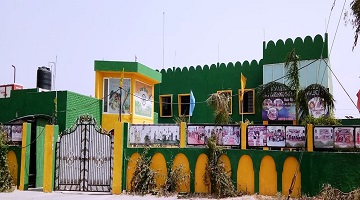To understand how our students thrive, you must first understand the physical arrangement of our classrooms. What may look like a mishmash is actually designed with students’ personal preferences – and right to choose how they want to learn – in mind. There are single student desks, tables to accommodate multiple students, couches, beanbag chairs, floor space, office chairs, and exercise balls. Rather than seeing traditional completed student work on the walls, you will see work in progress on the walls. Whiteboards cover our wall space and students use them during discussions to collaborate and record ideas. Their to do lists, sketches, and thoughts are as inspirational and stimulating a classroom display as you will ever see.
Our first floor houses all classrooms, the main office, and the cafeteria. Our second floor features our science lab, art studio, auditorium, and gymnasium.
Our Students
Students in every classroom collaborate extensively on micro and macro levels. Within their own classes, they work together on math problems, literary and art analysis, composing music, group presentations, and more. Students work in ways they find comfortable: at desks, standing, lying on the floor, sitting on a couch, using paper and pencil, or on iPads, laptops, and cell phones. As long as students are working productively and not interfering with their peers’ educations, we encourage their comfort in place of outdated ideas of how students “should” work. Our classes are inclusionary. Students with disabilities are students first and foremost. We believe every child has the right to work, play, and be with other children, and here, they are.
Rather than through tests, we seek evidence of learning in the actual work students do on an ongoing basis: their projects, presentations, journal entries, conversations, etc. Teachers and students adapt accordingly based on that most critical feedback. However, at the end of every unit in math, reading, writing, science, social studies, and foreign language, students do take “traditional” tests. Importantly, though, their grades are not used in a strictly summative sense. Rather than use these tests as a conclusion to a unit and an opportunity to say a student either “got it” or did not, we use them to guide our next steps. So, students who demonstrate difficulty with concepts are invited to attend early morning programs that focus on their misunderstandings or troublesome concepts. All of our teachers work with groups of four to six students. For morning groups, students are assigned to a teacher based on the teacher’s personal specialty. Groups are flexible from unit to unit. Our goal is not to have students do well on tests. It is, instead, for them to master content. The timeframe in which this is accomplished is of secondary importance.
At this school, our closely vetted, highly qualified teachers act more as guides toward learning than just imparters of knowledge. Teachers are expected to help students learn, and so you will never hear the excuse, “I taught it, but they didn’t learn it.” Teachers respond to the needs of their students as they arise and adapt their approach to the curriculum appropriately. This structure reflects our greater overall commitment to safeguarding the emotions and esteem of our students because we aim to make sure every student has the fullest opportunities to do their best. We value cultivating strong relationships that lead to confidence and risk taking.
To that end, we promote an idea called, “Awards for All.” We don’t reward high grades because inevitably only some students will ever win! We like to catch students doing STARFISH things. Our recognition focuses on character rather than achievement, and we celebrate students for being supportive, trying when something seems too difficult, exhibiting a positive, can do attitude, showing respect toward all, providing friendship, displaying integrity, sharing, and being helpful. These are attributes to which all students can aspire, and they give us common language to talk about our students’ development as people.


